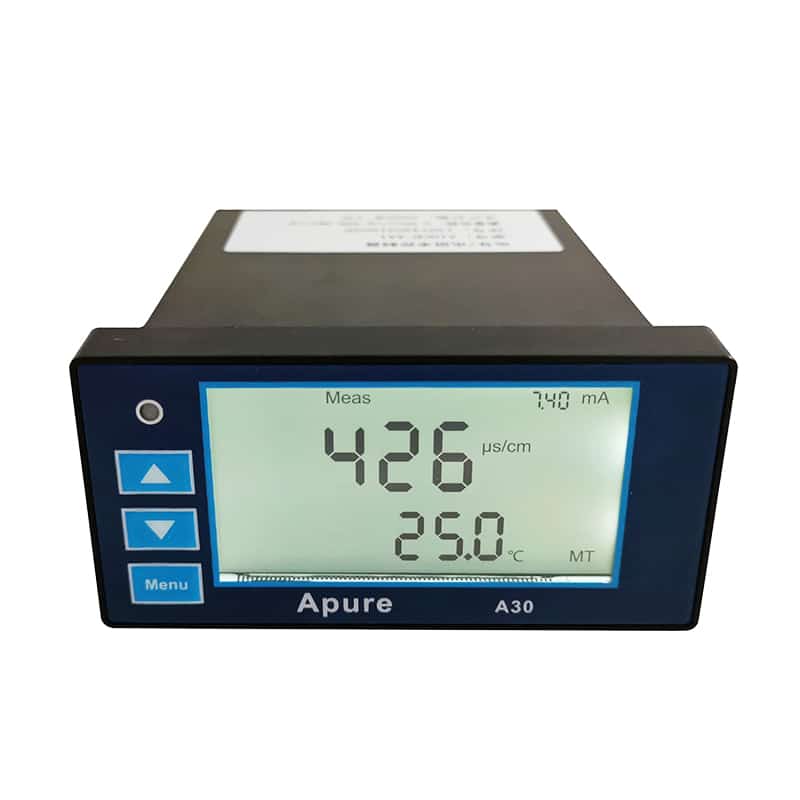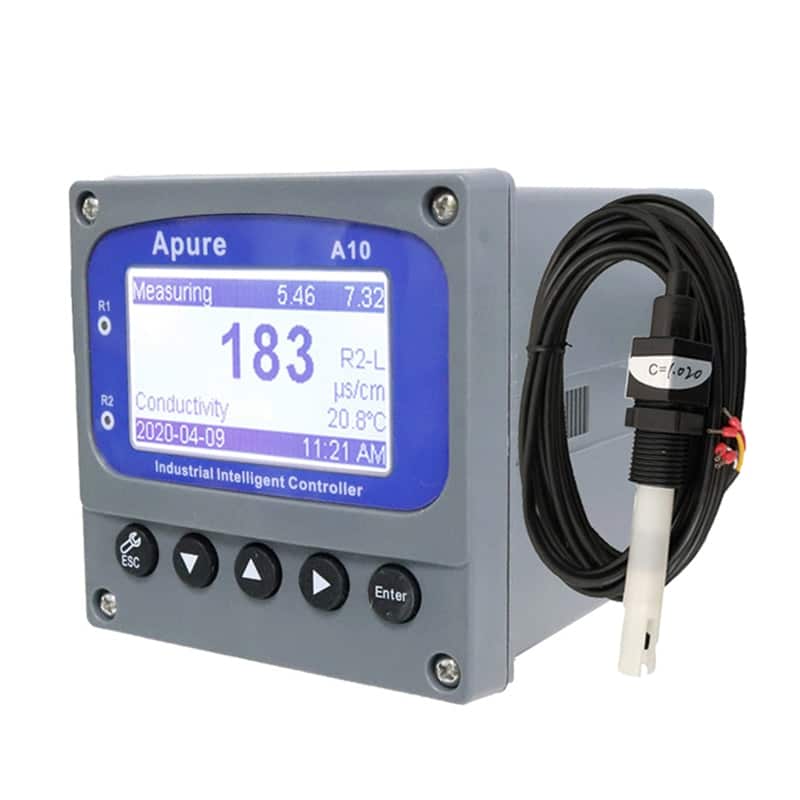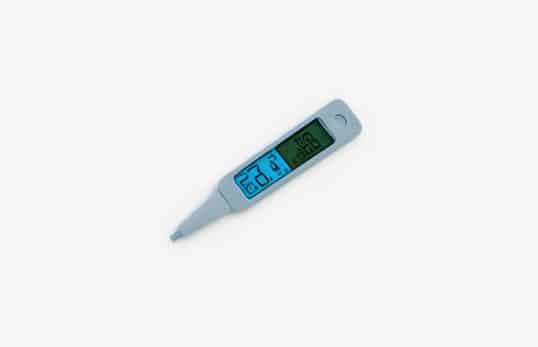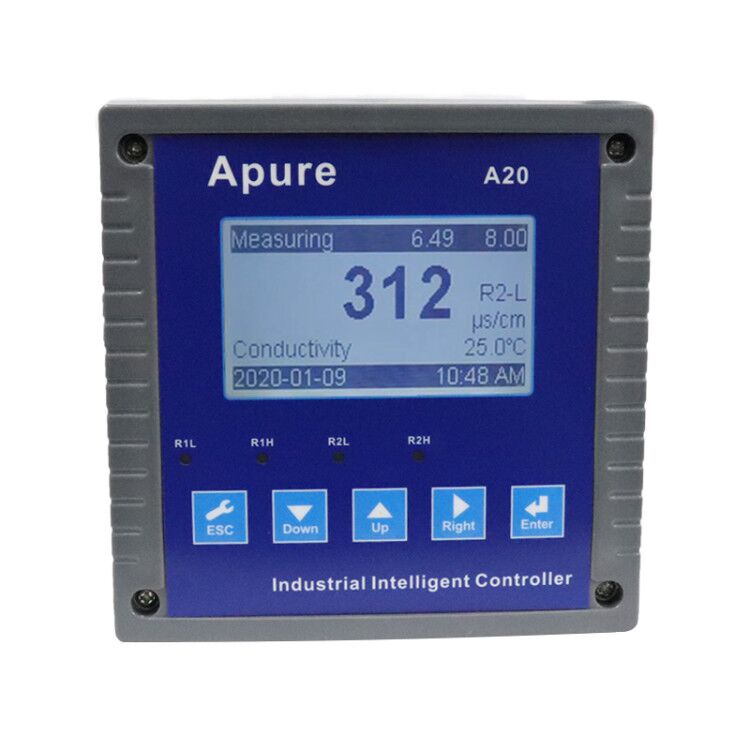A conductivity meter is an instrument used to measure the electrical conductivity of a liquid and is commonly used in the fields of water quality monitoring, chemical processing, and environmental monitoring. It evaluates the ionic concentration of a solution by measuring the ability of ions in a liquid to conduct electricity, thereby determining the purity and concentration of the solution. A conductivity meter usually consists of two electrodes, and as the conductivity increases, the resistance value measured by the meter decreases, and vice versa. In this way, conductivity meters can quickly and accurately detect the ionic concentration and purity level of a liquid, providing important data support for a variety of industrial and scientific applications.
Basics of conductivity
Concept and units of conductivity
Conductivity is a physical quantity that expresses the ability to conduct electricity in a solution. It reflects the ability of charged particles (ions) in a solution to conduct an electric current. The higher the conductivity, the higher the concentration of ions in the solution, the stronger the conductivity.
Units: Conductivity is measured in Siemens per meter (S/m) or micro Siemens per centimeter (µS/cm). 1 S/m = 1000 µS/cm.
Factors affecting conductivity
- Ion concentration: The higher the concentration of ions in the water, the higher the conductivity will usually be because more ions can participate in conducting electricity.
- Ion type: Different types of ions have different charges and mobilities and therefore contribute differently to conductivity. For example, heavy ions (e.g. Ca²⁺ and Mg²⁺) contribute more to the conductivity than light ions (e.g. Na⁺ and Cl-).
- Temperature: an increase in temperature increases the movement of water molecules and the mobility of ions, leading to an increase in conductivity.
- pH: Changes in pH affect the degree of ionization of water, which in turn affects conductivity.
- Total dissolved solids (TDS): Total dissolved solids is the total amount of all inorganic salts, organics, and elements dissolved in water. The higher the TDS, the higher the conductivity usually is.
Relationship between conductivity and water quality
Conductivity is an important parameter in water quality analysis because it indirectly reflects the purity and mineral content of the water:
- Pure water: low conductivity because there are almost no ions present.
- Mineral water: contains some amount of minerals and has a moderate conductivity.
- Hard water: contains high levels of calcium and magnesium ions and has a high conductivity, which can lead to scale and corrosion problems.
- Polluted water: conductivity may also be abnormally high if there are too many contaminants, such as heavy metals or organic pollutants, dissolved in the water.
Principle of operation of conductivity meter
The principle behind conductivity measurements is based on the ability of charged particles (usually ions) in a solution to conduct electricity. When the electrodes of a conductivity meter are immersed in a solution, an electric field is formed between the electrodes. If ions are present in the solution, these ions will move in response to the electric field and cause an electric current to flow. A conductivity meter measures the current density per unit length or per unit area, which is related to the concentration and mobility of ions in the solution. Therefore, the measured value of conductivity reflects the concentration of ions in solution and the conductive ability of the solution.
What does a conductivity meter consist of?
- Electrodes: A conductivity meter typically consists of two electrodes that are immersed in a solution to establish an electric field and measure conductivity.
- Conductivity sensor: Used to measure the conductivity between the electrodes and convert it to a conductivity value.
- Conductivity meter instrument: includes a display and control panel for displaying and recording the measured values and controlling the measurement parameters.
- Temperature compensation device: Taking into account the effect of temperature on conductivity, conductivity meters are usually equipped with a temperature sensor and a temperature compensation device to calibrate the measured value and provide accurate results.
Types of conductivity meters
There are various types of conductivity meters, and depending on the application scenario and usage requirements, you can choose the right type of conductivity meter. Common types of conductivity meters include portable, benchtop, pen, and online monitoring conductivity meters.
Portable conductivity meter
Features:
- Portability: small and lightweight, suitable for measurements in the field.
- Multi-functional: temperature compensation is often integrated to improve measurement accuracy.
- Battery-powered: no need for a power outlet, flexible in use.
Application scenario:
- Field water quality monitoring, such as rivers, lakes, and groundwater.
- Rapid testing at industrial sites.
- Emergency testing, e.g. water quality assessment at pollution accident sites.
Benchtop conductivity meter
Features:
- High accuracy: usually more accurate than portable conductivity meters, suitable for laboratory use.
- Multi-functional: with many functions, such as data logging, temperature compensation, and multi-parameter measurement.
- Stability: solid structure, suitable for long time continuous use.
The A30 Digital TDS EC Meter and A10 EC Electrical Conductivity Meter can provide the above features to help you better monitor conductivity.


Application scenario:
- Laboratory water quality analysis.
- Industrial process control laboratory.
- Teaching laboratories for student experiments and research.
Pen conductivity meter
Features:
- Affordable: low price for basic conductivity measurement needs.
- Easy to use: simple to operate, usually just need to insert into the water to read the data.
- Portability: small size, easy to carry.
Application scenario:
- Household water quality testing, such as conductivity measurement of tap water and drinking water.
- Simple on-site water quality checks.
- School and educational use for basic laboratory teaching.

Online monitoring conductivity meter
Features:
- Real-time monitoring: can continuously monitor water quality changes and output data in real time.
- Automation: usually integrated into automated systems for remote monitoring and data transmission.
- High durability: designed for long term stable operation, resistant to harsh environments.
The A20 EC Water Conductivity Tester measures pH/ORP and temperature simultaneously.

Application scenarios:
- Industrial process control, such as water quality monitoring in chemical, food, and beverage production.
- Continuous monitoring in water treatment facilities, such as wastewater treatment and water purification plants.
- Environmental monitoring stations for long-term water quality monitoring in rivers, lakes, and oceans.
Benefits of using a conductivity meter
- Ensure product quality and safety.
- Optimize chemical processes.
- Comply with regulatory standards.
Conductivity meter maintenance and calibration
Maintenance:
- Regular cleaning: clean the electrodes and sensor components of the conductivity meter periodically, using a mild detergent and a soft cloth, and rinse thoroughly.
- Replace electrodes and sensors
- Maintain a suitable environment: The conductivity meter should be used and stored in a dry, clean environment at a suitable temperature. Avoid exposing the instrument to extremes of temperature, humidity, or chemically corrosive substances to prevent damage and affect the accuracy of the measurements.
Calibration:
- Calibration frequency: It is generally recommended that calibration be performed every few months or once a year to ensure the accuracy and reliability of the measurement results.
- Use standard solutions
- Record calibration data
Summary
With regular maintenance and calibration, conductivity meters can be kept in good working order and provide accurate and reliable measurements. Whether in water quality monitoring, chemical processing, or food production, conductivity meters play an important role in helping us to ensure product quality and safety, optimize chemical processes, and meet regulatory standards.
Apure not only has conductivity meters but also offers a full range of water quality monitoring instruments, temperature measurement instruments, pressure measurement instruments, level measurement instruments, and flow measurement instruments to meet your every need. Apure products are reliable and affordable, with a complete after-sales service to make your water quality clearer! Contact us today.
